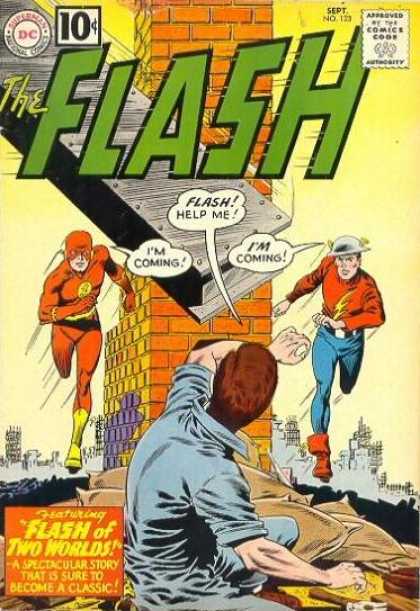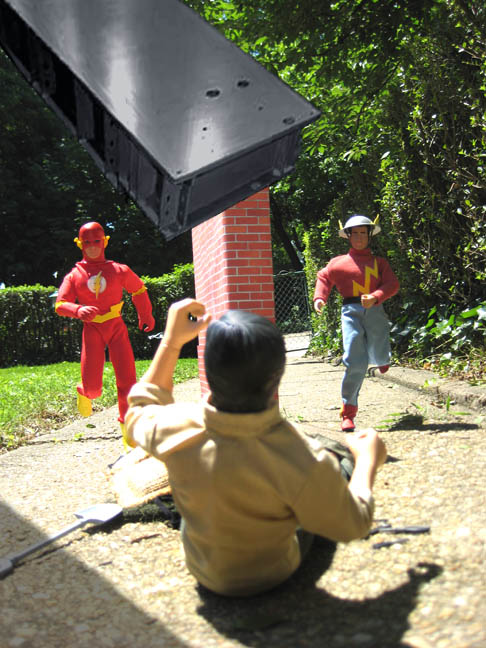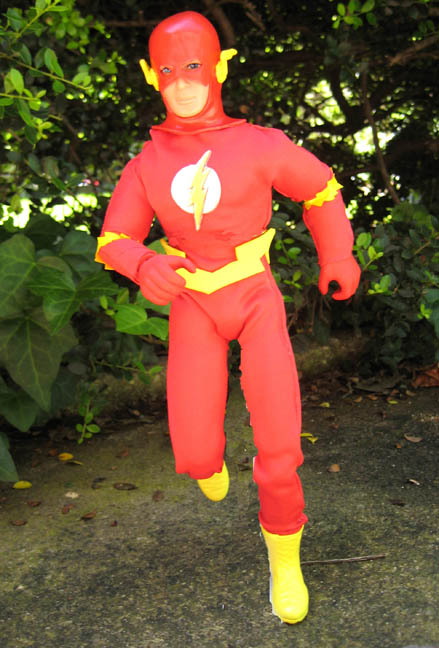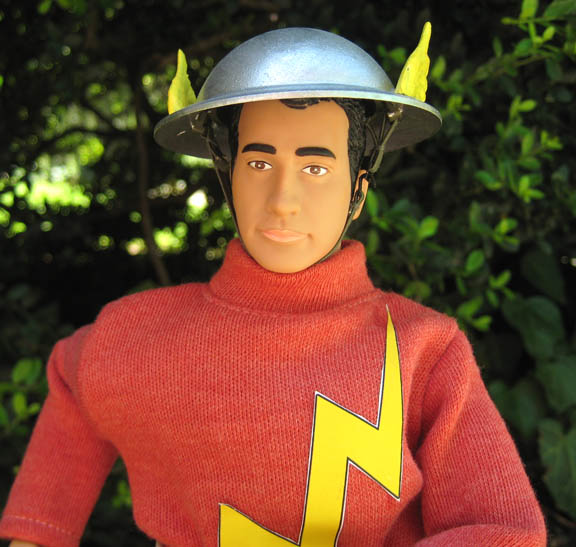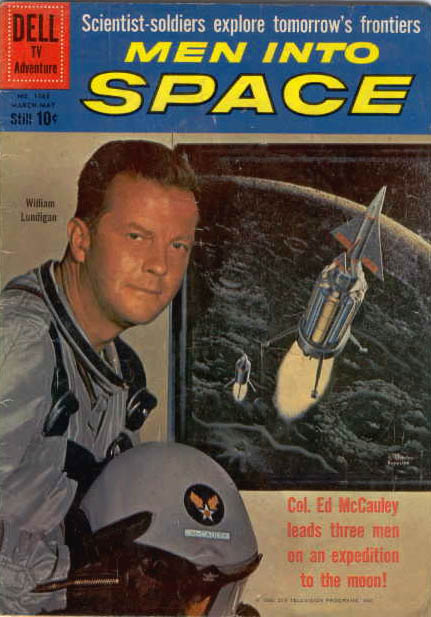
Just like the Silver Age Flash, I first discovered Silver Age Green Lantern not in comic books but on the Aquaman cartoon show where he appeared in both his own solo back-up stories and as part of the Justice League of America. The thing that fascinated me about Green Lantern was that he belonged to a larger intergalactic organization designed to police all the planets in space. That imbued him with a greater calling than these other super heroes who simply got hit by radiation or fell into a pile of chemicals and gained super powers. Hal Jordan was blessed with his powers, or at least given a ring and lantern that contained powers, by a far superior group of aliens. If Superman was a veiled representation of Jesus Christ, the Green Lantern was something like a prophet.
I first learned Green Lantern's origin in one of the cartoon installments. Test pilot Hal Jordan is suddenly transported to a desert area where a UFO has crash landed. The alien belongs to the Guardians of the Universe and, now that the alien is dying, he has chosen Jordan to pass on his membership to because he is a good man without fear. The alien gives Jordan a green ring and a green device that looks like a lantern. The lantern charges the ring every 24 hours and, whitgh the ring, he can create just about anything he wishes. Its only weakness is that the ring is powerless against the color yellow. This was one of those bullshit twists that I always hated in comic books, like Superman's kryptonite. These guardians are so powerful, but all you have to do is paint your gun yellow and they're screwed. Oh well...
I discovered that there had been a Golden Age Green Lantern when DC Comics started publishing old reprints in the back pages of their comics in the early 70s. While Silver Age Green Lantern's origin was pure atomic age sci-fi, the Golden Age version had an origin borrowing more from magic, which was pretty common with those early super heroes. Alan Scott stumbles across a magic lantern made of green metal which has mysterious powers. Scott creates a ring that, when he touches it to the lantern every 24 hours, gives him great powers. While Hal Jordan's ring could not affect anything yellow, Scott's ring was defenseless against items made of wood. I think Hal Jordan had the better advantage here.
Like The Flash, Green Lantern was one of the top five super heroes of DC's powerful stable who had his own magazine in addition to appearing regularly in an anthology title (All-American) and as part of the Justice Society of America in All-Star Comics. Also like The Flash, Green Lantern faded away in the early 50s as super hero comics fell out of favor. Once The Flash was successfully resurrected in a new form in 1956, Green Lantern got his aforementioned face lift in 1959 and the Silver Age was off and running.
I wasn't a regular reader of the Green Lantern comics, but he was always a big part of my childhood through his appearances on the Aquaman show and, of course, the Super Friends. When I renewed my interest in the old Captain Action toy during the late 90s, I found there was a lot of fans online who wished Ideal had made a Silver Age Green Lantern costume for Captain Action. Indeed, had the toy line been more successful, I have no doubt that The Flash and Green Lantern would've been turned into costume sets for the trans-super hero. Of course, I had to make a costume for my own Captain Action.
The elements for the costume came from the usual suspects. The gloves and boots were courtesy of Wes McCue at Classic Plastick. To simulate the green ring, I cut out a ring shape from green electrical tape and stuck it on the right glove hand. The costume was made by Rauty, which cleverly consists of a full black leotard over which you put on the green one-piece bathing suit type of garment. The chest emblem was made by finding a copy of the logo online, adjusting it to size in Photoshop, and then printing the logo on sitcker paper.
 The mask went through two versions. First, I used the mask that came with Playing Mantis's second generation Green Hornet costume over which I placed a green mask cut out of electrical tape. I had cut out the eye holes because Green Lantern was sometimes drawn with his eyes exposed. However, the Green Hornet face mask had bug eyes similar in look to Eagle Eye G.I Joe, and the hair style was all wrong. The finished mask didn't look anything like Hal Jordan.
The mask went through two versions. First, I used the mask that came with Playing Mantis's second generation Green Hornet costume over which I placed a green mask cut out of electrical tape. I had cut out the eye holes because Green Lantern was sometimes drawn with his eyes exposed. However, the Green Hornet face mask had bug eyes similar in look to Eagle Eye G.I Joe, and the hair style was all wrong. The finished mask didn't look anything like Hal Jordan.After awhile, it occurred to me that Hal Jordan had a pile of curly hair similar to Aquaman. Since Ideal had made an Aquaman costume set for Captain Action, maybe I could repaint an Aquaman mask. One finally came on eBay for a price I was willing to pay, and I repainted Aquaman's golden locks brown. I used the same electrical tape technique for the green mask, but decided to paint the eye holes plain white. With this new face mask, I was reasonably pleased with my Silver Age Green Lantern.

A few years later, when I was making custom figures of all the Justice Society of America characters, I took on the daunting task of recreating Golden Age Green Lantern. His was one of the more audacious costumes from the era, featuring a red shirt, green pants, red boots with yellow criss-cross striping, a purple mask, and a high-collared cape with purple on the outside and chartreuse on the inner lining. In today's vernacular, he was a hot tranny mess!
Although I was no longer making costumes specifically for Captain Action figures, I decided to repaint a spare Lone Ranger face mask to use for Alan Scott's head because of the similarity. His hair went from black to yellow and his mask went from black to purple. To mitigate the extreme color pallate, I dyed a white shirt in a soft red tone and I used some olive drab pants instead of bright green tights. The chest emblem was created in the same process mentioned above. On the red boots, courtesy of Wes McCue, I created the striping pattern with yellow electrical tape. I wanted to make the cape, but I could never find the material in the right colors. For the sake of this post, I mocked up a cape with a little photoshoppery. This is a reasonable representation of what I want my finished Green Lantern to look like when I get the right cape material.
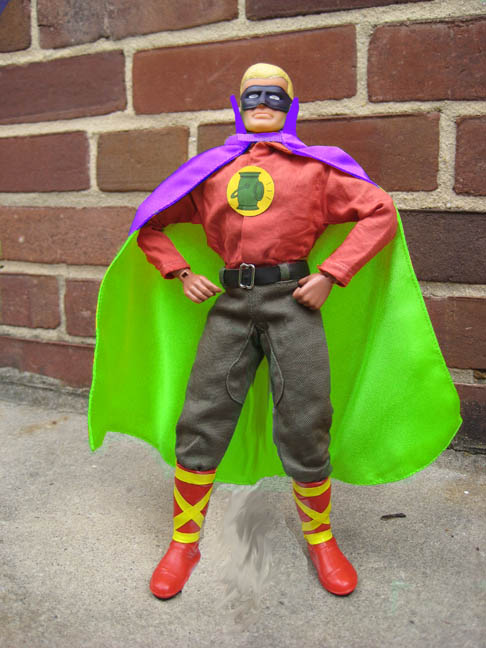
The Flash and Green Lantern survived through the 20th century by going through radical makeovers, but DC's other three big stars, Superman, Batman, and Wonder Woman, remained relatively unchanged throughout their careers. I'll talk about my Wonder Woman action figure next time.




